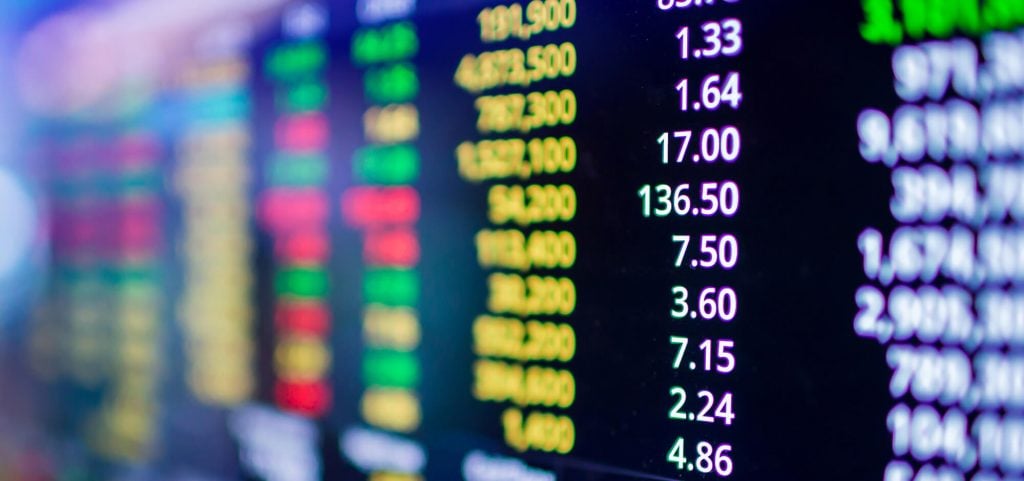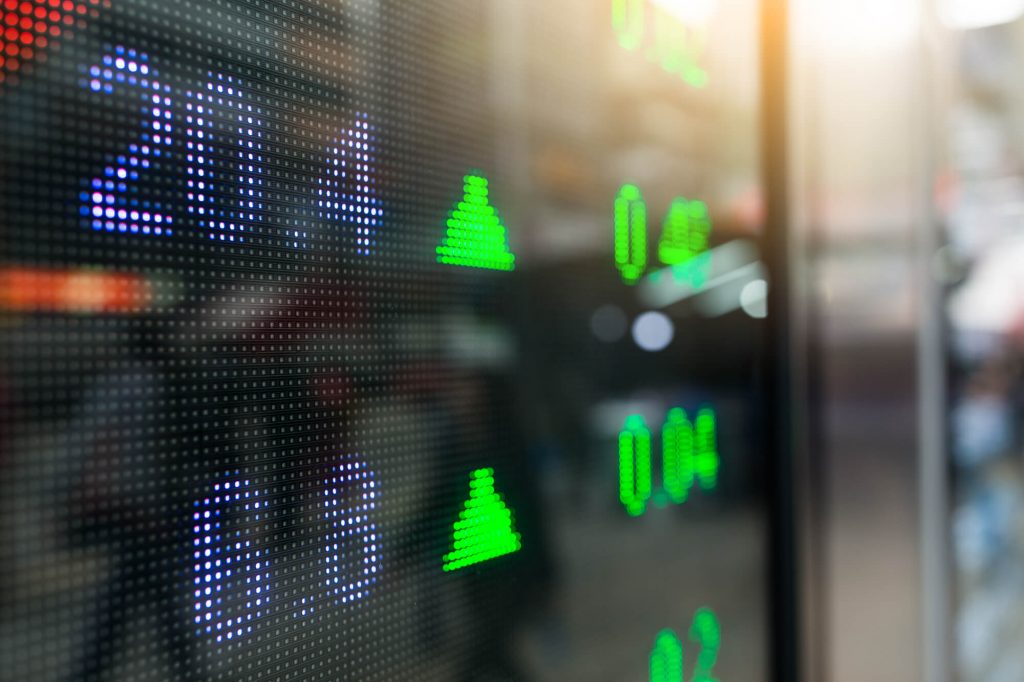
When the economy reopened after the pandemic, the stock market rebounded with a period of sustained growth. But industry experts now caution that concerns about inflation and a new COVID-19 variant could push us into a period of instability. If this happens, we can expect the growth we’ve seen in the market to be replaced by a high degree of stock market volatility.
If you’re new to the world of investing, this volatility can come as a bit of a shock—unless you’re prepared.
What is stock volatility? In this post, we’ll help you to understand stock market volatility and how it may impact your investment strategy moving forward.

What is Stock Volatility?
Stock volatility can refer to the movement in an individual stock, though it can also be applied to the stock market as a whole.
Volatile Stocks Definition
A volatile stock is one whose value fluctuates up and down, usually over a short period of time. Volatility can therefore be used to refer to the amount of uncertainty or risk associated with that stock, based on the changes in its value.
Typically, volatility is based on the degree to which the stock fluctuates from its average price. Volatility is usually described in terms of either a percentage or the dollar value of a stock’s deviation from the average price.
Standard deviation is the most common way to describe volatility. It can provide a snapshot of the stock’s performance during a particular time frame.
It’s possible to speak of historic volatility, too, which refers to the stock’s performance over the course of its lifetime. But smaller time periods can be particularly useful for investors. Daily, weekly, monthly, or annualized volatility can provide a clear indicator of a stock’s recent price changes.
Some analysts also calculate the ways a stock’s prices will likely fluctuate in the future, providing a measure known as implied volatility.
Characteristics of Volatile Stock Markets
While volatility can describe individual stocks, it’s also possible to speak of volatility in the market itself. What causes volatility in the entire market?
Volatile stock markets are usually caused by external events that create widespread uncertainty. For example, when there is uncertainty in the market’s performance as a whole, it can lead to a lot of frantic buying and selling. This is then reflected in the prices of stocks bouncing up and down based on investors’ behavior.
Volatile stock markets are typically associated with fear and uncertainty. Volatility can therefore be associated with bear markets, crashes, and other large-scale economic events.
It’s important to understand that volatility by itself cannot measure the overall direction of the stock market. Instead, volatility can simply tell you how big the price swings are.
Why is Stock Volatility Important?
Why is it so important to understand stock market volatility? After all, shouldn’t we naturally expect the market to rise and fall over time?
Yes and no. It’s true that you should expect stock prices to rise and fall over time. But volatility refers to dramatic changes over a short period of time. Understanding this volatility can help you to gauge the risk involved with investing in any particular stock.
How to Calculate Volatility in Stocks
We can add to our volatile stocks definition by exploring how volatility is calculated. Volatility in stocks can be calculated using two methods:
- Variance
- Standard deviation
Standard deviation is simply the square root of the variance. Let’s use an example so you can understand how these calculations work.
Variance
To calculate a stock’s variance, you can follow the following formula:
- Find the mean (average) of the stock’s closing costs
- Determine the difference between each value and the mean
- Square these deviations
- Add these squared deviations together
- Divide the sum of these deviations by the number of values
For simplicity, let’s pretend that Stock X has monthly closing prices of $1 through $6 over a 6-month period. That means that it closed at $1 in January, $2 in February, etc.
First, we’ll find the mean of the closing costs. Adding each of our closing costs, you get a value of $21. Divide this by 6, and you get an average monthly closing cost of $3.50.
Next, you can calculate the difference between each month’s value and the mean. Then you square these deviations. Doing this, you get the following results (squared values are in parentheses):
- January: $1—$3.50 = $-2.50 ($6.25)
- February: $2—$3.50 = $-1.50 ($2.25)
- March: $3—$3.50 = $ -0.50 (0.25)
- April: $4—$3.50 = 0.50 ($0.25)
- May: $5—$3.50 = $1.50 ($2.25)
- June: $6—$3.50 = $2.50 ($6.25)
Now, you add these squared values together. In our example, this sum comes to $17.50. Next, we divide this sum by the number of values. Your final variance is $2.92. Phew!
Keep in mind that stocks in the real world will rarely be this simple, so you may want to get used to using a spreadsheet to perform these calculations at a rapid pace.
Standard Deviation
The standard deviation is the square root of the variance. In our above example, the standard deviation comes to $1.71. This value will indicate how far the stock’s price typically deviates from its average price.
How Stock Market Volatility is Measured
Variance and standard deviation can reveal how a stock performs relative to itself. But if you want to know how a stock performs compared to the market as a whole, you can turn to two ways of measuring stock volatility: The beta and the VIX.
Beta
A beta can measure a stock’s volatility relative to a stock market benchmark, usually the S&P 500.
For example, a stock with a beta value of 1.5 has historically moved 150% for every 100% move in the benchmark. A stock with a beta value of 0.75 has only moved 75% for every 100% move in the benchmark.
This can be helpful because it indicates the degree to which an individual stock resembles the market as a whole. A stock with a low beta is therefore less volatile than the whole market.
If you’re looking for long-term investments, stocks with low betas might be expected to remain more stable, even if you see larger fluctuations in the market itself.
Volatility Index (VIX)
The Chicago Board Options Exchange (CBOE) created the volatility index (VIX) to gauge the volatility of the market over a 30-day period.
The VIX relies on real-time quote prices of S&P 500 call and put options. Essentially, the VIX is a gauge of the future bets investors are making on the direction of individual stocks on the market as a whole.
Because the VIX is based on future market performance, it’s commonly called the “fear index.”
A high reading on the VIX indicates a lot of risk associated with the market because it could mean that prices could change dramatically in the near future. Conversely, a low VIX indicates that stock prices are expected to remain relatively steady for the foreseeable future.

Can You Profit from High-Volatility Stocks?
For some investors, a volatile market may sound like a dream come true. After all, couldn’t you conceivably buy a stock when its price dips, then sell it again when its price rebounds?
Day traders may rely on these rapid fluctuations as part of their day-to-day strategy. But high-volatility stocks come with risks and rewards that must be understood and respected before you make your investment.
Risks of High-Volatility Stocks
When you’re investing in high-volatility stocks, the assumption is that you can buy a stock at a low price and sell when it rebounds. In principle, this is a clear-cut strategy. But in real life, it requires quick, decisive action, as well as management of your risks.
A quick market order can leave you vulnerable to “slippage.” Slippage refers to the difference in price between the time that the order is placed and the time it is finally sold.
For example, a day trader may place an order when Stock X is at a low price, but it’s possible for the stock to rebound before his order is finalized. If this happens, the investor has purchased the stock for a much higher price than he intended.
Secondly, these investments assume rapid rebounds. Taking advantage of this often means staying glued to your screen in the hopes of seeing your investments take off. Some do; others don’t. This means that there are significant risks in putting your money into highly volatile stocks.
Rewards of High-Volatility Stocks
Others argue that the rewards of day trading outweigh the risks. According to an article in The Balance, you can manage risk by placing a stop-loss order that ensures you sell a stock if it dips below a certain value.
This is certainly a way to minimize risk, though a stop-loss order doesn’t guarantee that your stock will be sold at that value; it could sink significantly lower.
Still, the siren call of short-term profits can be alluring to many day traders and other short-term investors that can leverage the fluctuating values of volatile stocks into immediate profits.
Best Practices for Investing in Volatile Stocks
If you want to try your hand in investing in volatile stocks, here are a few tips:
- Invest in small amounts to minimize risk
- Expect to profit from multiple transactions rather than one “big score”
- Make informed decisions based on research rather than your gut
- Never, never invest money you can’t afford to lose
There’s a difference between investing and gambling. Investors rely on extensive knowledge and research to make their investment choices. Even day traders rely on these tools to make the best choices they can.
Gamblers, on the other hand, are just looking for a place to put their chips down, seeking to generate a profit for the short term. Before you consider day trading, spend some time learning more about the investment process. The articles and resources at GorillaTrades are a great place to start!
Stock Volatility and Long-Term Investing
How does volatility impact long-term investing? On the surface, long-term investments might not seem to be impacted by stock market volatility—at least not for the long haul.
While periods of price fluctuation can impact a stock’s value for the short term, these fluctuations don’t necessarily impact the stock’s value during the time it’s in your portfolio. For long-term investors, it’s more important to consider a stock’s long-term growth potential — not volatility.
However, there are still situations in which volatility can matter to long-term investors. Long-term investors may also wish to consider low-volatility stocks to completely minimize risk.
Stock Market Volatility and Retirement
Volatility matters when you’re preparing to sell your stocks. If you’re approaching retirement, it may be important to monitor the volatility of your investment portfolio. If your assets are experiencing volatility, you may consider waiting a bit before you retire to minimize any potential losses from stocks that are performing erratically.
Use Low-Volatility Stocks to Stabilize Your Portfolio
Long-term investment relies on growth potential more than the day-to-day prices of an individual stock. Still, many investors may choose to invest in low-volatility stocks to minimize risk altogether or to stabilize their portfolio by balancing low-volatility stocks with high-volatility investments.
In late 2020, Kiplinger released a list of low-volatility stocks that could be used to stabilize your investment portfolio. This list includes:
- Republic Services (RSG)
- Cerner (CERN)
- Johnson & Johnson (JNJ)
- Bristol-Myers Squibb (BMY)
- Costco Wholesale (COST)
- Colgate-Palmolive (CL)
Again, volatility doesn’t communicate anything about a company’s growth potential, which is how you grow your assets. But volatility does indicate how much the company’s stock will deviate from its average price, providing a more stable investment for your overall portfolio.

Invest Wisely with GorillaTrades
If you’re looking to make an investment in the stock market, we’re here to help. GorillaTrades offers a treasure trove of great resources and content to help investors of any level.
Subscribers receive daily newsletters, stock picks, and can even receive text message alerts to provide up-to-the-minute updates on stock performance. Our member’s only website is jammed with great content, tutorials, and trading ideas that can help you achieve financial success.
Sign up today for a free, 30-day trial subscription to GorillaTrades. We’re confident that you’ll find our tools and features to be well worth the investment.
